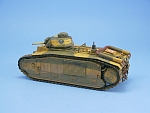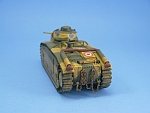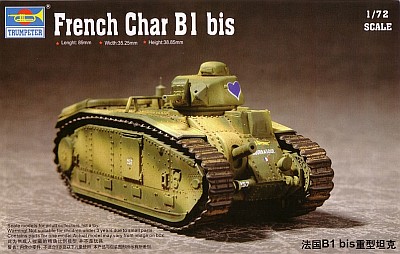| The kit contains
58 parts molded in a nice light grey plastic that is the perfect hardness,
plus two soft rubber band style tracks molded in black. Also included
is a nicely printed decal sheet and instructions.
It appears that this kit is heavily
inspired by the Tamiya 1/35 scale version of the Char B1bis. For example,
there are three rectangular holes on the underside of the body which
are identically placed when compared to the same holes as found on
the Tamiya kit (I wasn't sure if they should actually be there so
I filled them in when I built the kit), and the parts look very much
alike, and in some places appear to assemble in the same manner. The
instructions give no indication as to what units the markings are
for, but a web search revealed that Trumpeter had just copied the
first two options as found in the Tamiya kit, that being:
- Option 1: Serial number 257 "Bourrasque",
2nd Section, 1st Company, 15th Combat Tank Battalion, 2nd Armored
Division, France 1940.
- Option 2: Serial number 481 "Vercingetorix",
3rd Company, 46th Combat Tank Battalion, 4th Armored Division, France
1940.
The instructions are a major disappointment
regarding decal placement. The first option, serial number 257, was
well illustrated and the decal placement covered most of the images.
Missing was the location for the second white serial number 257, so
I followed the Trumpeter and Tamiya box art and added it to the crew
access door on the starboard side of the tank. I also discovered later
that there is a miniscule heart on the decal sheet that should have
been placed on the cover of the front headlight (I didn't notice this
on the box top picture of the Tamiya kit until after I had finished
this build).
As for the second option, the modeller
is pretty much left in the dark as to where the decals are to be placed.
The instructions show where to put the roundel and vehicle number
on the turret but the remaining markings for the vehicle name, serial
number, and so forth aren't shown on the diagram, so I would suppose
the modeller would have to assume that they go in the same places
as for tank 257, or locate a set of Tamiya instructions and follow
them.
Part B1, which mounts the front left
idler wheel, has a large ejector pin mark to remove. The locating
peg at the front of the lower hull (part A1) got in the way of a tight
fit with the upper hull piece so I trimmed it off.
The barrel for the hull gun is molded
as a one piece hollow barrel, a nice touch that saves the modeler
from having to drill open the end. I drilled out the holes for the
turret gun muzzle and the two small holes in the upper front of the
turret gun's mantlet.
I suggest that you add the hull gun
cover (part B19) to the lower hull at step 4. My test fitting found
trying to add it after the hull pieces are joined in step 10 was most
difficult. Adding it at an earlier step allows you to get it in place
without any interference with the hull and its gun.
I found the spacer located under the
lower end of the exhaust pipe was a bit too long and didn't allow
the pipe to sit well and stopped it from attaching to the mount point
on the hull just aft of the radio antenna. I just sanded them down
a tad and the problem disappeared.
There were a couple of major items
that needed modification. Trumpeter has incorrectly molded the driver's
visor and the kidney shaped periscope cover on the top of the driver's
position. They have molded
it in reverse, with the periscope tube on the outside of the hull
as opposed to the inside. If you look at the inside of the upper hull
you can see the kidney shaped cover there. Quite odd actually.
Dmitriy Sidorenko
informs us that in later versions of this kit, this issue has been
fixed.
_t.jpg)
_t.jpg)
_t.jpg)
The cover was quite easy to fix. I
carefully trimmed off the handle and sanded the area smooth. Then
I fashioned the kidney shape cover from some plastic sheet and glued
it in place. The final touch was to add the small bump on the top
of the cover from some plastic rod.
The driver's visor correction was more
complex and a lot more work. At first I thought of just removing the
whole visor but cringed at the amount of work it appeared to be. So
with a sharp Exacto knife I cut off the bottom portion of the visor
at the point where it breaks towards the body and sanded the area
smooth. I then vertically notched the remaining potion of the visor,
first by making slanting cuts with the knife to start the notch and
then finishing it off with a flat file used on its edge. Once I had
the notch to the point I liked it, I filled it in with a piece of
rectangular plastic rod and then sanded/scraped it flush to the original
visor, filled and sanded the area smooth.
After all of this there are a few rivets
to be added just beneath the visor. I have my own method of adding
rivets that I use when I have only a few to do. It is slow work but
if you're careful it works well for a small number of rivets. I take
a piece of heat stretched sprue and some gel super glue and add the
rivets by dipping the tip of the stretched sprue into the glue and
then carefully, and lightly dabbing a drop where I want it. Right
after I have the drops of glue in place I set them with some super
glue accelerant flowed onto the drops from the side. I do this so
the drops aren't affected by gravity and flatten out while they set
on their own.
So after all this work, the change,
though not perfect, is dramatic and looks much closer to what it should
compared with the original Trumpeter effort.
There is a set of four tiny holes in
the rear end cover of the upper body, which on the Tamiya kit are
for some hooks plus some chain to drape over the hooks. There weren't
any hooks in this kit, and since I thought it would look cool to have
the same look to my kit as was found on the Tamiya kit, I opened up
the holes slightly and inserted some hooks fashioned from thin copper
wire and then added some chain. The chain I use is from a fine necklace
that I purchased from my local Walmart jewelry department. The kit
also lacks the tow hooks which I scratch built.
There are two options for the fenders:
early or late styles. The instructions do not specify which to fender
option goes with which marking option so I chose the early style on
the assumption that the tank was an early version because its serial
number was lower than the second marking option. You also have the
choice of early or late exhaust pipes and I chose the early option
to match the fender choice. Referring back to the Tamiya kit I also
noticed that tank 257 had the early style exhausts while 481 has the
later style, so it would appear that the early style fenders and early
exhausts should be the ones to use for 257 while the later style options
would be the ones for 481.
I left off the fenders during painting
so I could weather the tracks and add them to the tank afterwards.
With the fenders out of the way I found the routing of the tracks
was much easier. I started the tracks at the midpoint of the upper
run which would hide the join once the fenders were attached.
As for the rubber band tracks themselves,
they are not too bad. They are just a tad too long and need trimming,
but this is much more preferable than the other option - being too
short. The tracks attached well with Testors Super Glue. Watch how
you place them along the long run at the bottom. Make sure they square
up with the wheels as it is quite easy to get a wave in the run due
to the flexibility of the tracks.
The decals are some of the best I have
seen come with a kit. They are nice and thin and don't leave a noticeable
edge once I settled them down with a good soaking in Microsol.
So in conclusion, to me the Trumpeter
Char B1bis appears to be a scaled down knockoff off of the Tamiya
1/35 scale kit. It is a nicely manufactured model kit with only a
few items that need to be addressed to make it more accurate.










Review sample purchased by the author. |
